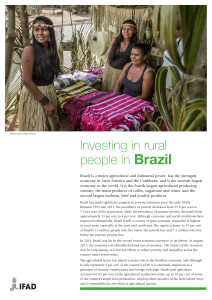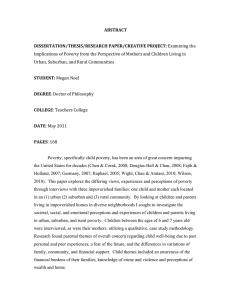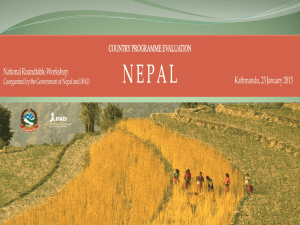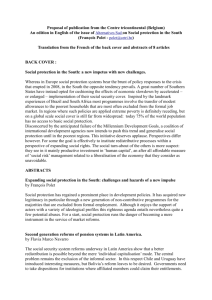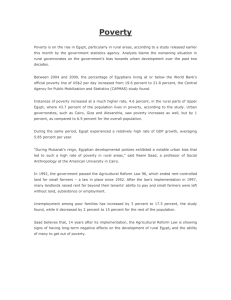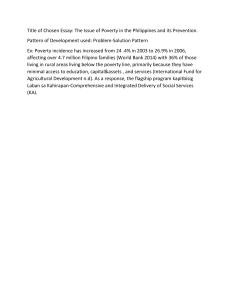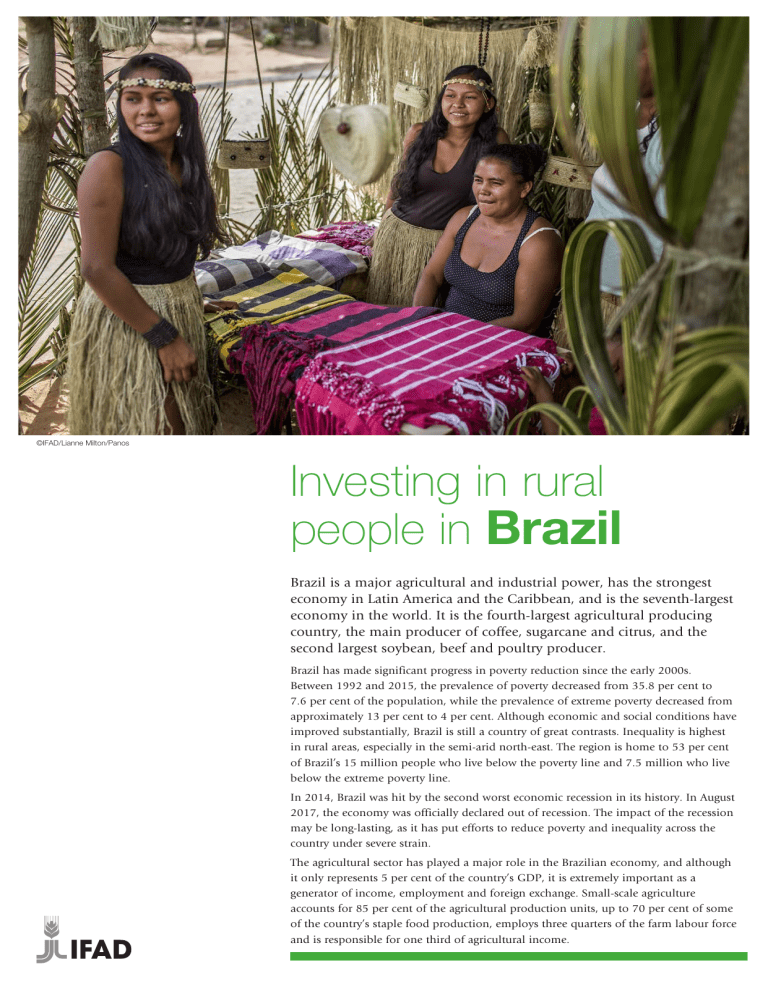
©IFAD/Lianne Milton/Panos Investing in rural people in Brazil Brazil is a major agricultural and industrial power, has the strongest economy in Latin America and the Caribbean, and is the seventh-largest economy in the world. It is the fourth-largest agricultural producing country, the main producer of coffee, sugarcane and citrus, and the second largest soybean, beef and poultry producer. Brazil has made significant progress in poverty reduction since the early 2000s. Between 1992 and 2015, the prevalence of poverty decreased from 35.8 per cent to 7.6 per cent of the population, while the prevalence of extreme poverty decreased from approximately 13 per cent to 4 per cent. Although economic and social conditions have improved substantially, Brazil is still a country of great contrasts. Inequality is highest in rural areas, especially in the semi-arid north-east. The region is home to 53 per cent of Brazil’s 15 million people who live below the poverty line and 7.5 million who live below the extreme poverty line. In 2014, Brazil was hit by the second worst economic recession in its history. In August 2017, the economy was officially declared out of recession. The impact of the recession may be long-lasting, as it has put efforts to reduce poverty and inequality across the country under severe strain. The agricultural sector has played a major role in the Brazilian economy, and although it only represents 5 per cent of the country’s GDP, it is extremely important as a generator of income, employment and foreign exchange. Small-scale agriculture accounts for 85 per cent of the agricultural production units, up to 70 per cent of some of the country’s staple food production, employs three quarters of the farm labour force and is responsible for one third of agricultural income. The agricultural sector, however, shows a strong dichotomy. Most of its dynamism is created by corporate agriculture and driven by the production of export commodities, mostly harvested in the south, south-east and centre-west regions and the MATOPIBA area. Family farming is still characterized by low economic dynamism and a high incidence of poverty, especially in the north-east. Brasilia Eradicating rural poverty in Brazil The main causes of poverty are inequality and exclusion, which in rural areas take the form of lack of access to land and basic services (health care, financial services, formal education and skills training). Over the past two decades, Brazilian authorities have addressed those issues with a range of policies and measures, including a gradual agrarian reform that has been implemented since the mid-1990s and the broadening of the scope of technical assistance services to make them more accessible. Since the second half of the 1990s, Brazil has increasingly addressed the issue of poverty. The Fome Zero (Zero Hunger) and Brasil Sem Miséria (Brazil without Poverty) programmes, among others, have improved the livelihoods of millions of people. In the area of family farming, Brazil has developed a number of public policies, including funding and public purchase programmes. Once neglected, family farmers are now central to the government’s poverty reduction strategy, as both beneficiaries and food suppliers. Family farming accounts for up to 70 per cent of production of some staple foods After the macroeconomic stabilization in the second half of the 1990s, different Brazilian administrations have increasingly addressed the issue of poverty. The Bolsa Escola (School Allowance), Fome Zero and Brasil Sem Miséria programmes have lifted hundreds of thousands of people out of poverty. The Bolsa Escola served as an umbrella programme for the multiple conditional cash transfer initiative Bolsa Familia (Family Stipend), while Brasil Sem Miséria was instrumental in achieving the Millennium Development Goal of reducing extreme poverty in the country, with Brazil surpassing the target. The poverty headcount in 2012 stood at 9 per cent, down from 21 per cent in 2005 and 34 per cent in 1996. The rate of extreme poverty was 3.6 per cent in 2012 compared with 13.4 per cent in 1990. In 2014, Brazil managed to exit FAO’s world map of malnutrition. IFAD’s strategy in Brazil In Brazil, IFAD investments focus on rural development activities in the north-east semi-arid region of the country, known as Sertão. IFAD started collaborating with Brazil’s federal and state governments in the 1980s. In 2016, IFAD approved its first loan outside of the semiarid region, in the transition pre-Amazonic area in the state of Maranhão. In 2017, another project will be approved for Pernambuco, still in the north-east, but in the Agreste pre-Sertão area and the coastal Atlantic rainforest area. In 2018, a top-up of the Piauí project will be approved. Maranhão and Piauí are two of the poorest states in Brazil. One factor that singles out Brazil in IFAD operations is that the majority of loan operations are done directly with the states, which are the borrowers, while the federal government provides the guarantee. Currently, there are six ongoing projects (five with state governments and one with the federal government). Brazil has the largest IFAD portfolio in Latin America, corresponding to about 50 per cent of the portfolio. Total financing in the country is equivalent to US$450 million, reaching US$560 million by 2018 with the new loan operations and the top-up. About 60 per cent is counterpart financing, mainly by federal and state governments and beneficiaries. All IFAD-supported projects in the country focus on supporting and promoting family farming. The goal is to increase family farmers’ production and income by facilitating their access to essential services, strengthening their organizations and connecting them to markets. Activities also target the most marginalized groups, such as indigenous and quilombola (Afro-descendant) communities, agrarian reform settlers, women and youth. IFAD-supported projects are well known for providing family farmers with appropriate tools to thrive in north-eastern Brazil’s harsh environment. Key activities include: • Organic and agroecological production methods • Water collection and conservation technologies • Participatory planning methodologies that incorporate both innovation and traditional knowledge Over the years, the lessons learned from IFAD-funded operations in Brazil have been shared with government officials, development partners, civil society, the private sector and family farmers via policy dialogue forums and the knowledge-sharing programme, Semear. Networking for scaling up is a key feature of IFAD’s country programme, which is now expanding its web of international cooperation among strategic partners, United Nations agencies, and both Brazilian and international financial institutions. Ongoing operations Bahia: Rural Sustainable Development Project in the Semi-arid Region of Bahia (Projeto Pro Semiárido) The objective of this project is to reduce rural poverty through increased production, creation of employment and income-generating opportunities. It aims to strengthen the capacities of individuals and organizations, connecting them to markets. Project components include: • Promoting the capacities of the target population, mainly through the participatory formulation and implementation of business or workplans • Funding agricultural production, agroprocessing and non-agricultural businesses IFAD has developed a strategic partnership with the federal and state governments and civil society actors This US$105.8 million project (including an IFAD contribution of US$45.0 million) operates in 30 municipalities with high incidences of poverty in the northern semi-arid area of Bahia, benefiting 70,000 poor rural families. Ceará: Productive and Capacity Development in the State of Ceará (Projeto Paulo Freire) The objective of this project is to reduce poverty and raise the living standards of family farmers in the state of Ceará by enhancing the productive base of rural households. The project has two components: • B uilding the individual and collective capacity of family farmers and strengthening public and private agencies that provide them with technical and managerial services • F inancing productive development initiatives to increase productivity and add value The project targets approximately 60,000 poor rural households. Total investment is US$94.9 million, with IFAD financing US$32.2 million. Paraíba: Cariri and Seridó Sustainable Development Project (PROCASE) The project helps poor rural people living in the semi-arid region of Paraíba to improve their livelihoods by developing the region’s rural economy. The project will focus on: • Developing human and social capital • Improving smallholder production • Combating desertification and promoting sustainable natural resource management Piauí - Viva o Semiárido Project Paraíba - PROCASE Project Ceará - Paulo Freire Project Sergipe - Dom Távora Project Dom Hélder Câmara II Project Bahia – Pro-semiárido Project " Brasilia ICO-Salvador Office Maranhão - Rural Poverty Alleviation Project IFAD’s operations are concentrated in the north‑east, the most poverty‑stricken rural area of Brazil The project, with a total cost of US$49.7 million, to which IFAD contributes US$25.0 million, will directly benefit about 18,500 households. Piauí: Semi-arid Sustainable Development Project in the State of Piauí (Viva o Semiárido) The project’s goal is to reduce extreme poverty among rural people in the semi‑arid region of Piauí by improving their income and increasing their employment opportunities through: • Training and technical assistance on the use of sustainable technologies • Enabling participants to access financial services • Strengthening social and productive organizations • Financing investments such as small dams, processing plants and irrigation systems With a total cost of US$39.1 million (US$20.0 million from IFAD), the project will directly benefit 22,000 households. Sergipe: Rural Business for Small Producers Project (Projeto Dom Távora) IFAD invests in rural people, empowering them to reduce poverty, increase food security, improve nutrition and strengthen resilience. Since 1978, we have provided US$18.5 billion in grants and low-interest loans to projects that have reached about 464 million people. IFAD is an international financial institution and a specialized United Nations agency based in Rome – the UN’s food and agriculture hub. The overall goal of this US$37.8 million project (with an IFAD contribution of US$16.0 million) is to generate sustainable rural employment in some of Sergipe’s poorest municipalities. The beneficiaries work in agricultural and non-agricultural activities. Specifically, the project aims to: • Develop agricultural and non-agricultural rural businesses of poor producer groups • Build capacity for rural business promotion through training and partnerships with local institutions and universities The project’s target group encompasses 12,000 poor rural families. Dom Helder Câmara II: Policy Coordination and Dialogue for Reducing Poverty and Inequalities in Semi-arid North-east Brazil (Projeto Dom Helder Câmara) The overall goal of this federal project is to reduce rural poverty and inequality in the semi-arid north-east. To reach this goal, the project works to improve policy dialogue, territorial planning, and coordination of public policies and programmes. The project’s development objectives include: • Promoting the dissemination of innovative production methodologies and technologies • Strengthening the capacities of rural communities to participate in decision‑making processes • Promoting increased family income based on agroecological approaches • Contributing to the reduction of gender, generational, racial and ethnic inequalities The project will benefit 74,000 households in 129 municipalities in seven states. Its total cost is US$125.3 million. Maranhão: Rural Poverty Alleviation Project in the State of Maranhão Maranhão is the second largest state in north-east Brazil and one of the poorest in the country. The project is to benefit 29,700 families in 600 communities in 43 municipalities of the state, paying special attention to the needs of rural women and youth, as well as to traditional communities – indigenous peoples, Afro-descendants (quilombolas) and fishers (caiçara), among others. The project aims to reduce rural poverty and inequalities based on gender and ethnicity by promoting sustainable and inclusive development. One of the main objectives of the project is to improve the capacity of rural people to participate effectively in the local development process and to manage their organizations better. The impetus for communities’ social and political participation goes hand in hand with the work to strengthen their economic capacity. To achieve these goals, the project is to provide training and technical assistance. For the most part, it will build on existing resources, such as the networks of communityrun technical schools, such as the Family Farming Schools (Escolas Família Agrícola) and Rural Family Houses (Casas Familiares Rurais), which have been suffering from serious infrastructure constraints. Contacts: Paolo Silveri Country Programme Manager, IFAD Via Paolo di Dono, 44 Rome, Italy Tel: +39 06 5459 2409 Fax: +39 06 5459 3409 Email: p.silveri@ifad.org Hardi Michael Wulf Vieira Country Programme Officer, IFAD United Nations Shared Office Praça Municipal Thomé de Souza, S/N, Ed. Elevador Lacerda CEP 40.020-010 Salvador-BA, Brazil Tel: +55 71 3183 5721 Email: h.vieira@ifad.org Leonardo Bichara Rocha Country Programme Officer, IFAD United Nations Shared Office Praça Municipal Thomé de Souza, S/N, Ed. Elevador Lacerda CEP 40.020-010 Salvador-BA, Brazil Tel: +55 71 3183 5714 Email: l.bichararocha@ifad.org International Fund for Agricultural Development Via Paolo di Dono, 44 - 00142 Rome, Italy Tel: +39 06 54591 - Fax: +39 06 5043463 Email: ifad@ifad.org www.ifad.org ifad-un.blogspot.com www.facebook.com/ifad instagram.com/ifadnews www.twitter.com/ifadnews www.youtube.com/user/ifadTV October 2017
